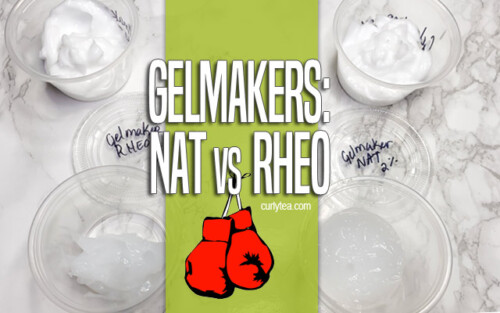Hey curlyteas! I received an email question asking if there are any major differences between Gelmaker NAT and Gelmaker RHEO. One of your fellow members wants to buy a cold processable polymer and narrowed it down to one of the two. She wanted to know the differences before making a purchase.
I already have both of these emulsifying and thickening agents. So let’s take a look to see if there are any differences between the two other than the ingredients used to create them.
Gelmaker NAT
Sodium acrylate/sodium acryloyldimethyl taurate copolymer, C15-19 alkane, polyglyceryl-6 laurate, polyglycerin-6
- No need for heat
- No neutralization needed
- No white rub-in
- Sensitive to electrolytes
- Light, soft, clean feel on the skin
- Max oil load: 35%
Gelmaker RHEO
Sodium polyacrylate, ethylhexyl cocoate, PPG-3 benzyl ether myristate, polysorbate 20
- No need for heat
- No neutralization needed
- No white rub-in
- Sensitive to electrolytes
- Light, silky, silicone-like feel on the skin
- Max oil load: 30%
Now let’s get a little more specific.
VIDEO
Gelmaker NAT
Sodium acrylate/sodium acryloyldimethyl taurate copolymer, C15-19 alkane, polyglyceryl-6 laurate, polyglycerin-6
What: Pre-neutralized anionic thickener which also emulsifies up to 35% oils, including silicones and vegetable oils. It can be used as a primary emulsifier or used to stabilize other emulsions (just be careful of those electrolytes).
Used for
- Gel creams
- lotions
- creams
- emulsified gel
- mascara
- foundation
Pros
- Doesn’t have to be heated
- Doesn’t have to be neutralized
- “Smooth, nude skin feel” that absorbs quickly without white rub-in
- Works in pH range of 5.5 – 12
- Can be used as a primary emulsifier
- Quick-breaking during rub-in
Cons
- Sensitive to electrolytes including additives like potassium azeloyl diglycinate
- May not work well with ingredients that need a very low pH (less than 4) to function well (example: glycolic acid).
HOW TO USE
- If you’re making an emulsion with oil soluble ingredients, add Gelmaker NAT to the oil phase and mix.
- Combine oil phase and water phase. Mechanical mixing is preferred.
- Mix for 2-3 minutes if using a frother (possibly less when using a stick blender)
- If gel does not form, one or more of your ingredients is probably an electrolyte
FORMULA FOR EMULSION
50 grams total
PHASE A
93.4% distilled water
2% glycerin
PHASE B
2% caprylic/capric triglyceride [3]
0.6% phenylpropanol EHG
2% gelmaker NAT*
*Notice how the gelling agent is added to oil soluble ingredients before mixing with PHASE A (water soluble ingredients)
FORMULA FOR GEL
25 grams total, no preservative
PHASE A
96% distilled water
2% glycerin
PHASE B
2% gelmaker NAT**
**Don’t save this. It is not preserved.
Gelmaker RHEO
Sodium polyacrylate, ethylhexyl cocoate, PPG-3 benzyl ether myristate, polysorbate 20
What: Pre-neutralized polyacrylate polymer which also emulsifies up to 30% oils including silicones. It can create thick creams without heating.
Used for
- Gel creams
- emulsified gels
- lotions
- creams
- mascara
- foundation
Pros
- Doesn’t need heat to thicken
- Doesn’t have to be neutralized to thicken
- “Silky, silicone-like feel” that absorbs quickly without white rub-in
- Thickens immediately
- Can be used as a primary emulsifier
Cons
- Sensitive to electrolytes and additives like potassium azeloyl diglycinate
FORMULA FOR EMULSION
50 grams total
PHASE A
93.4% distilled water
2% glycerin
PHASE B
2% caprylic/capric triglyceride [3]
0.6% phenylpropanol EHG
2% gelmaker RHEO*
*Notice how the gelling agent is added to oil soluble ingredients before mixing with PHASE A (water soluble ingredients)
FORMULA FOR GEL
25 grams total, no preservative, throw away
PHASE A
96% distilled water
2% glycerin
PHASE B
2% gelmaker RHEO**
**Don’t save this. It is not preserved.
FINAL THOUGHTS
Without oil-based ingredients, Gelmaker NAT creates a clearer gel than Gelmaker RHEO. However, neither ingredient creates crystal clear carbomer/HEC looking gels.
They both feel great on the skin. There’s no draggy feeling from the ingredients themselves. Gelmaker RHEO creates slightly more viscous products: the peaks are stiffer and the gel is more opaque. In contrast, Gelmaker NAT creates slightly less viscous emulsions and slightly clearer gels. It’s hard to see on camera but is noticeable in person.
It’s not a hard and fast rule, but I’d use Gelmaker NAT if I want to make clearer serums or very light gels for the skin. I’d use Gelmaker RHEO for standard cream gels or if there was something I wanted to build more viscosity into, like a night cream or a super moisturizing gel cream.
Be careful though because BOTH are sensitive to electrolytes but they serve similar purposes. Don’t think you’re going to load this up with extracts and aloe vera, and have a gel after mixing. More than likely it won’t gel at all.
But for many things, like a hydrating face gel or moisturizing overnight cream, either should work well. The choice is up to you!
Happy DIYing!
